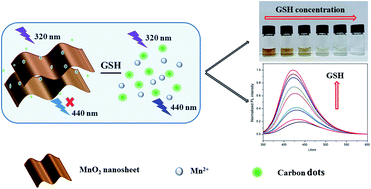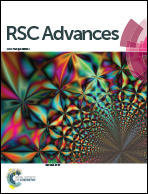An ultrasensitive colorimetric and fluorescence dual-readout assay for glutathione with a carbon dot–MnO2 nanosheet platform based on the inner filter effect†
Abstract
An ultrasensitive colorimetric and fluorescence dual-readout assay based on the inner filter effect (IFE) was developed for glutathione (GSH) determination, in which carbon dots (C-dots) were used as a fluorophore and MnO2 nanosheets as an absorber. Due to the excellent optical absorption properties of MnO2 nanosheets and the good spectral overlap between the fluorophore and absorber, MnO2 nanosheets could effectively quench the fluorescence of C-dots via the IFE. As the target, GSH could reduce MnO2 nanosheets to Mn2+ ions, which inhibited the IFE and resulted in the fading of solution color and the recovery of the fluorescence signal. And these two kinds of signals were respectively used for qualitative and quantitative detection of GSH. The results showed that this proposed assay could distinguish 10 μM GSH with the naked eye and quantitatively detect GSH within the concentration range of 0.1–400 μM. The limit of detection was 6.6 nM. Moreover, this assay showed sensitive responses in human serum and urine samples, which indicated that this IFE-based assay has great potential in GSH-related clinical and bioanalytical applications.



 Please wait while we load your content...
Please wait while we load your content...